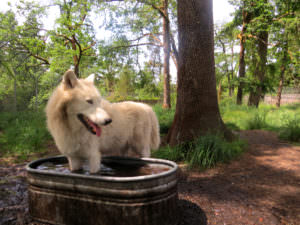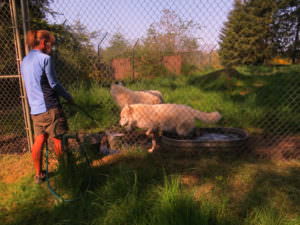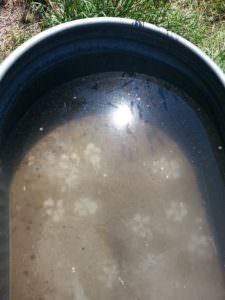Riley's spirit continues in our hearts
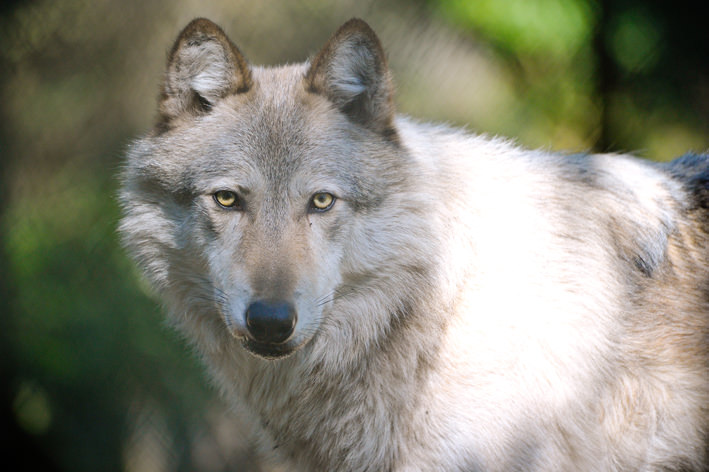
Our friend Riley
photo by Julie Lawrence/Wolf Haven International
It is with a heavy heart that Wolf Haven writes that our friend Riley passed away earlier this month. Riley was only seven years old and was healthy and happy. His passing was very sudden and unexpected and left us all in a state of great sadness.
During a routine morning walk through the sanctuary by animal care staff on Friday December 12, Riley was found lying on his side not moving. It was apparent that he had passed away during the night. The day before he died, Riley was his usual happy, playful self. Two weeks earlier he had been introduced to a new companion, a female wolf named Ukiah, whose brother had died. The two of them were forming a fast friendship and could be seen nose to nose wagging their tails, playing a little and lying quietly next to each other in the middle of their enclosure.
The day he passed he had been given a special treat, a small sheep carcass donated to Wolf Haven by a local farmer. Riley did not want to share the carcass with Ukiah at first. He kept chasing her off until he ate his fill and then he moved away to allow Ukiah to enjoy as well.
When Riley was found the following morning, his abdomen was acutely distended; an indication of gastric dilation volvulus (GDV), where the stomach fills with gas and twists on itself. We consulted our veterinarian about performing a necropsy in order to determine the cause of his death. The veterinarian felt that given all of the symptoms and the large amount of food Riley had quickly ingested the day before, a necropsy was not necessary. She explained that GDV, also known as torsion, evolves extremely quickly, making it nearly impossible to prevent and very difficult to treat successfully, especially in wild canids. Riley (as well as our other wolves) received carcasses on a regular basis without any ill-effects, so we are not sure why on this particular day it turned out to have fatal consequences.
It has been an honor to care for Riley and watch him blossom with his first companion Siri and his burgeoning new friendship with Ukiah. He was a little shy and was also playful and mischievous. He will be greatly missed.
Thank you for your generosity, care and support of Riley while he was with us at Wolf Haven. His spirit will continue on in our hearts.

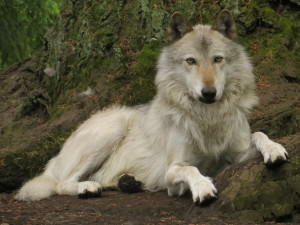
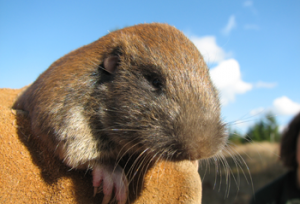





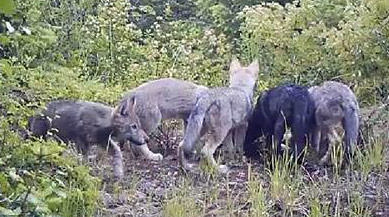
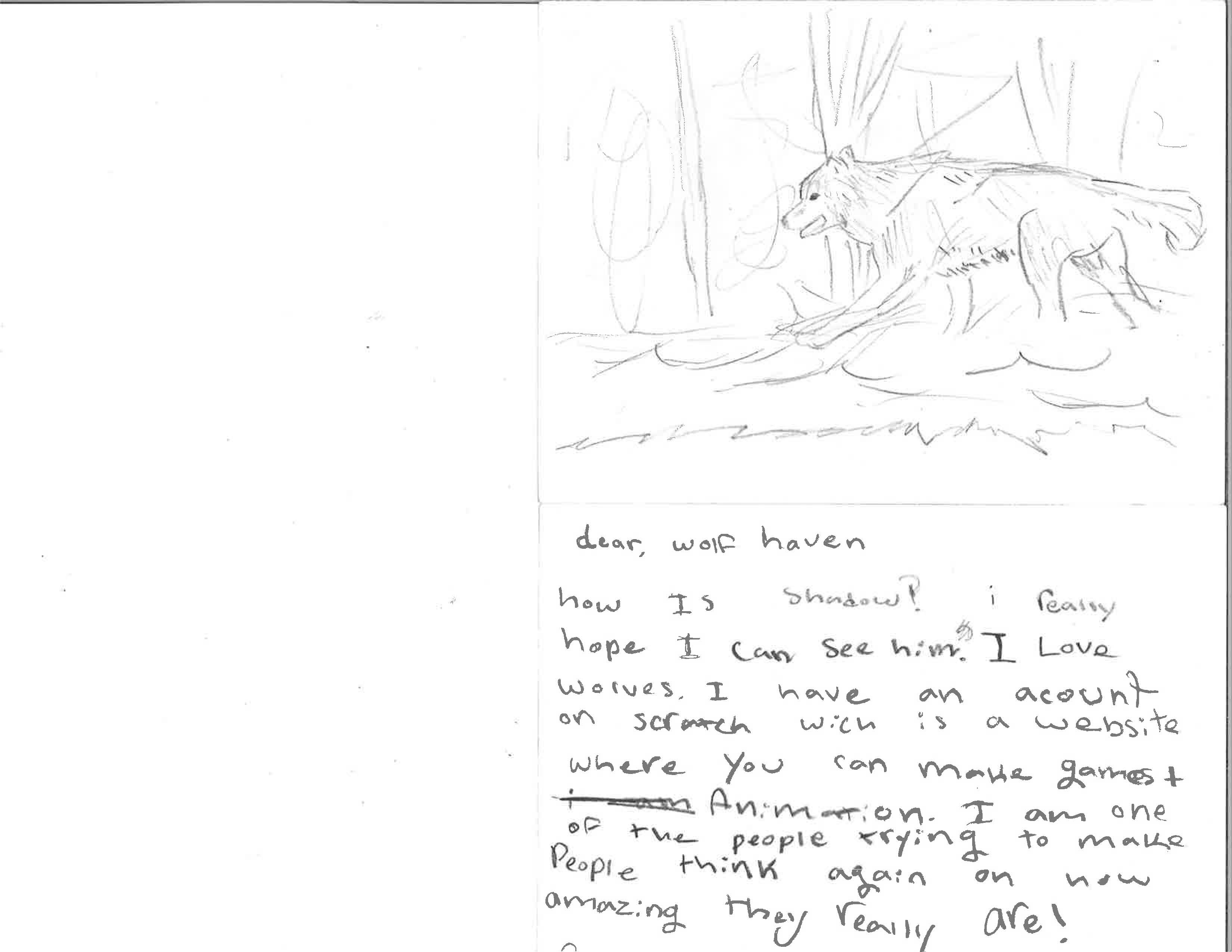
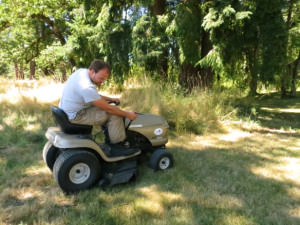 The Pacific Northwest is known for its rainy days, but the summer usually brings lots of sun. As you might guess, this is a great recipe for plants to grow, more specifically, grass. The animal care staff tries to mow the grass in the sanctuary on the footpaths outside of the enclosures on Tuesdays, since we are closed for visits. Our mowing routine is nothing out of the ordinary; one person cuts the roads with the rider mower, two people weed whack closer to the fences and around obstacles. As with everything that needs to get done in the sanctuary, we do it with the animal’s well-being and comfort as the top priority.
The Pacific Northwest is known for its rainy days, but the summer usually brings lots of sun. As you might guess, this is a great recipe for plants to grow, more specifically, grass. The animal care staff tries to mow the grass in the sanctuary on the footpaths outside of the enclosures on Tuesdays, since we are closed for visits. Our mowing routine is nothing out of the ordinary; one person cuts the roads with the rider mower, two people weed whack closer to the fences and around obstacles. As with everything that needs to get done in the sanctuary, we do it with the animal’s well-being and comfort as the top priority.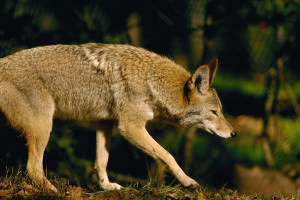 Wolves are neophobic, or afraid of new things. Unlike dogs, wolves are not very brave and outgoing when it comes to new things in their environment. Coyotes are braver than wolves which is why they have been so successful integrating with people and our urban ways. So when it comes to cutting grass, you would expect our residents to stay away from us and the mowers. Guess again! There seems to be two reactions to mowing day; indifference, and curiosity.
Wolves are neophobic, or afraid of new things. Unlike dogs, wolves are not very brave and outgoing when it comes to new things in their environment. Coyotes are braver than wolves which is why they have been so successful integrating with people and our urban ways. So when it comes to cutting grass, you would expect our residents to stay away from us and the mowers. Guess again! There seems to be two reactions to mowing day; indifference, and curiosity.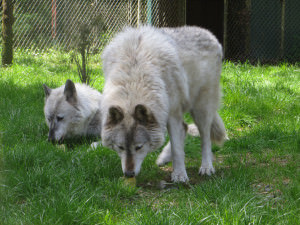 Indifference. There are some residents that just don’t seem to care that the animal care staff is operating loud machinery. Indifference is mostly manifested by them continuing to lie on the ground or carrying on with their normal routine. Some indifferent wolves include Jesse and Shiloh and Mehina and Klondike.
Indifference. There are some residents that just don’t seem to care that the animal care staff is operating loud machinery. Indifference is mostly manifested by them continuing to lie on the ground or carrying on with their normal routine. Some indifferent wolves include Jesse and Shiloh and Mehina and Klondike.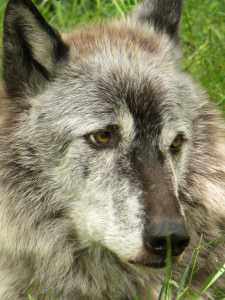 Curiosity. This is the reaction most residents have and it baffles me. Mowing day is met not with fear, but active interest. Even skittish animals seem to have a newfound bravery when the mower is around. Since Shoka arrived at the sanctuary, he has been wary of me. I catch glimpses of him and hear huffs as I walk past during feeding or doing the walkthrough. I do what needs to be done and I move on. But just this morning as I was on the rider mower, I went past Shoka’s enclosure and he was about five feet away from the fence just watching. No huffing. No running to the back of the enclosure. Just watching.
Curiosity. This is the reaction most residents have and it baffles me. Mowing day is met not with fear, but active interest. Even skittish animals seem to have a newfound bravery when the mower is around. Since Shoka arrived at the sanctuary, he has been wary of me. I catch glimpses of him and hear huffs as I walk past during feeding or doing the walkthrough. I do what needs to be done and I move on. But just this morning as I was on the rider mower, I went past Shoka’s enclosure and he was about five feet away from the fence just watching. No huffing. No running to the back of the enclosure. Just watching.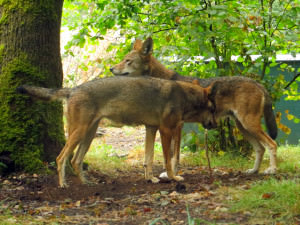 Red wolves Ruby and Tala, while hard to see on visits, are often at the fence in full view while we are mowing the grass. Same goes for the coyotes. Some wolves like Lonnie, will rub the fence line after the mower or weed whacker has passed to get the fresh-cut grass smell. After all, who doesn’t like that?
Red wolves Ruby and Tala, while hard to see on visits, are often at the fence in full view while we are mowing the grass. Same goes for the coyotes. Some wolves like Lonnie, will rub the fence line after the mower or weed whacker has passed to get the fresh-cut grass smell. After all, who doesn’t like that?